French New Wave's Influence: Post-War Ideologies, Cinema, and Culture
VerifiedAdded on 2023/04/22
|8
|2591
|153
Essay
AI Summary
This essay delves into the French New Wave, a transformative film movement that emerged in post-war France, challenging traditional cinematic norms and profoundly impacting culture and society. It explores the movement's origins, its opposition to conventional filmmaking, and its embrace of personal artistic expression, influencing filmmakers like Godard. The essay examines the New Wave's reflection of post-war ideologies, including political shifts and social changes, particularly the rise of left-wing and right-wing perspectives. It analyzes the movement's stylistic innovations, such as rapid editing, on-location shooting, and improvised dialogue, and its engagement with social and political upheavals. Furthermore, the essay discusses the influence of the New Wave on subsequent generations of filmmakers and its lasting legacy in the evolution of cinema, highlighting how it redefined French politics and culture.
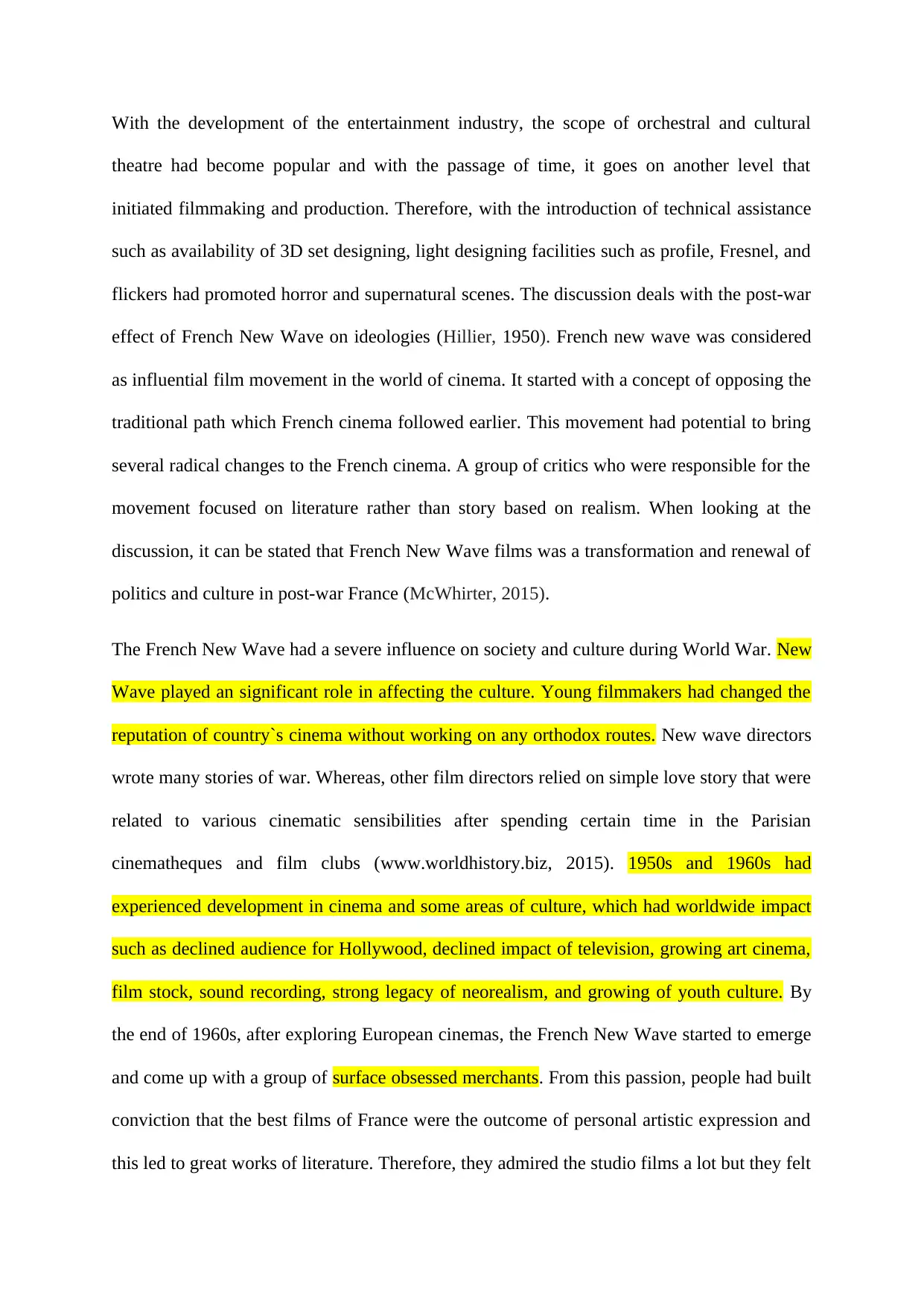
With the development of the entertainment industry, the scope of orchestral and cultural
theatre had become popular and with the passage of time, it goes on another level that
initiated filmmaking and production. Therefore, with the introduction of technical assistance
such as availability of 3D set designing, light designing facilities such as profile, Fresnel, and
flickers had promoted horror and supernatural scenes. The discussion deals with the post-war
effect of French New Wave on ideologies (Hillier, 1950). French new wave was considered
as influential film movement in the world of cinema. It started with a concept of opposing the
traditional path which French cinema followed earlier. This movement had potential to bring
several radical changes to the French cinema. A group of critics who were responsible for the
movement focused on literature rather than story based on realism. When looking at the
discussion, it can be stated that French New Wave films was a transformation and renewal of
politics and culture in post-war France (McWhirter, 2015).
The French New Wave had a severe influence on society and culture during World War. New
Wave played an significant role in affecting the culture. Young filmmakers had changed the
reputation of country`s cinema without working on any orthodox routes. New wave directors
wrote many stories of war. Whereas, other film directors relied on simple love story that were
related to various cinematic sensibilities after spending certain time in the Parisian
cinematheques and film clubs (www.worldhistory.biz, 2015). 1950s and 1960s had
experienced development in cinema and some areas of culture, which had worldwide impact
such as declined audience for Hollywood, declined impact of television, growing art cinema,
film stock, sound recording, strong legacy of neorealism, and growing of youth culture. By
the end of 1960s, after exploring European cinemas, the French New Wave started to emerge
and come up with a group of surface obsessed merchants. From this passion, people had built
conviction that the best films of France were the outcome of personal artistic expression and
this led to great works of literature. Therefore, they admired the studio films a lot but they felt
theatre had become popular and with the passage of time, it goes on another level that
initiated filmmaking and production. Therefore, with the introduction of technical assistance
such as availability of 3D set designing, light designing facilities such as profile, Fresnel, and
flickers had promoted horror and supernatural scenes. The discussion deals with the post-war
effect of French New Wave on ideologies (Hillier, 1950). French new wave was considered
as influential film movement in the world of cinema. It started with a concept of opposing the
traditional path which French cinema followed earlier. This movement had potential to bring
several radical changes to the French cinema. A group of critics who were responsible for the
movement focused on literature rather than story based on realism. When looking at the
discussion, it can be stated that French New Wave films was a transformation and renewal of
politics and culture in post-war France (McWhirter, 2015).
The French New Wave had a severe influence on society and culture during World War. New
Wave played an significant role in affecting the culture. Young filmmakers had changed the
reputation of country`s cinema without working on any orthodox routes. New wave directors
wrote many stories of war. Whereas, other film directors relied on simple love story that were
related to various cinematic sensibilities after spending certain time in the Parisian
cinematheques and film clubs (www.worldhistory.biz, 2015). 1950s and 1960s had
experienced development in cinema and some areas of culture, which had worldwide impact
such as declined audience for Hollywood, declined impact of television, growing art cinema,
film stock, sound recording, strong legacy of neorealism, and growing of youth culture. By
the end of 1960s, after exploring European cinemas, the French New Wave started to emerge
and come up with a group of surface obsessed merchants. From this passion, people had built
conviction that the best films of France were the outcome of personal artistic expression and
this led to great works of literature. Therefore, they admired the studio films a lot but they felt
Paraphrase This Document
Need a fresh take? Get an instant paraphrase of this document with our AI Paraphraser
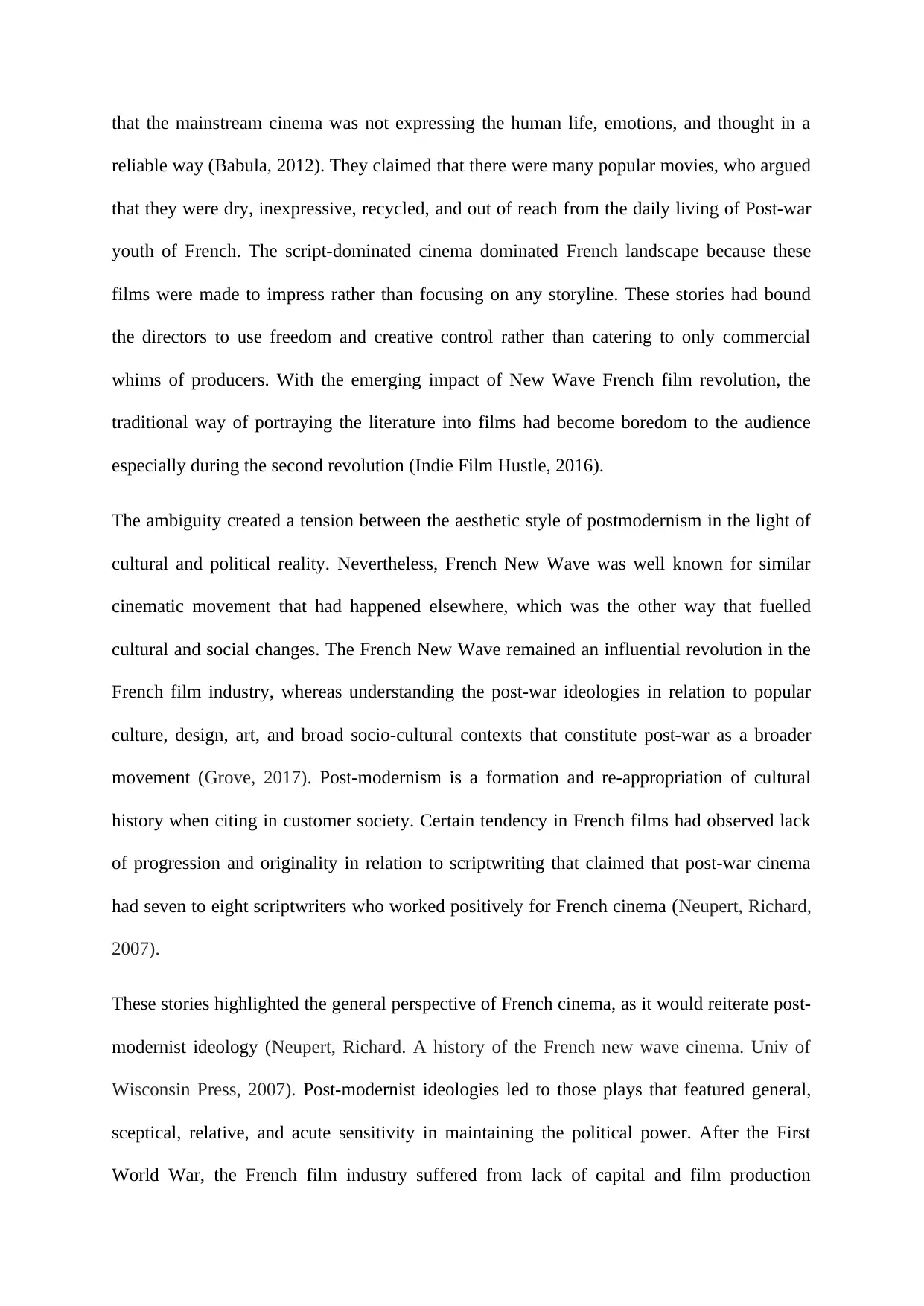
that the mainstream cinema was not expressing the human life, emotions, and thought in a
reliable way (Babula, 2012). They claimed that there were many popular movies, who argued
that they were dry, inexpressive, recycled, and out of reach from the daily living of Post-war
youth of French. The script-dominated cinema dominated French landscape because these
films were made to impress rather than focusing on any storyline. These stories had bound
the directors to use freedom and creative control rather than catering to only commercial
whims of producers. With the emerging impact of New Wave French film revolution, the
traditional way of portraying the literature into films had become boredom to the audience
especially during the second revolution (Indie Film Hustle, 2016).
The ambiguity created a tension between the aesthetic style of postmodernism in the light of
cultural and political reality. Nevertheless, French New Wave was well known for similar
cinematic movement that had happened elsewhere, which was the other way that fuelled
cultural and social changes. The French New Wave remained an influential revolution in the
French film industry, whereas understanding the post-war ideologies in relation to popular
culture, design, art, and broad socio-cultural contexts that constitute post-war as a broader
movement (Grove, 2017). Post-modernism is a formation and re-appropriation of cultural
history when citing in customer society. Certain tendency in French films had observed lack
of progression and originality in relation to scriptwriting that claimed that post-war cinema
had seven to eight scriptwriters who worked positively for French cinema (Neupert, Richard,
2007).
These stories highlighted the general perspective of French cinema, as it would reiterate post-
modernist ideology (Neupert, Richard. A history of the French new wave cinema. Univ of
Wisconsin Press, 2007). Post-modernist ideologies led to those plays that featured general,
sceptical, relative, and acute sensitivity in maintaining the political power. After the First
World War, the French film industry suffered from lack of capital and film production
reliable way (Babula, 2012). They claimed that there were many popular movies, who argued
that they were dry, inexpressive, recycled, and out of reach from the daily living of Post-war
youth of French. The script-dominated cinema dominated French landscape because these
films were made to impress rather than focusing on any storyline. These stories had bound
the directors to use freedom and creative control rather than catering to only commercial
whims of producers. With the emerging impact of New Wave French film revolution, the
traditional way of portraying the literature into films had become boredom to the audience
especially during the second revolution (Indie Film Hustle, 2016).
The ambiguity created a tension between the aesthetic style of postmodernism in the light of
cultural and political reality. Nevertheless, French New Wave was well known for similar
cinematic movement that had happened elsewhere, which was the other way that fuelled
cultural and social changes. The French New Wave remained an influential revolution in the
French film industry, whereas understanding the post-war ideologies in relation to popular
culture, design, art, and broad socio-cultural contexts that constitute post-war as a broader
movement (Grove, 2017). Post-modernism is a formation and re-appropriation of cultural
history when citing in customer society. Certain tendency in French films had observed lack
of progression and originality in relation to scriptwriting that claimed that post-war cinema
had seven to eight scriptwriters who worked positively for French cinema (Neupert, Richard,
2007).
These stories highlighted the general perspective of French cinema, as it would reiterate post-
modernist ideology (Neupert, Richard. A history of the French new wave cinema. Univ of
Wisconsin Press, 2007). Post-modernist ideologies led to those plays that featured general,
sceptical, relative, and acute sensitivity in maintaining the political power. After the First
World War, the French film industry suffered from lack of capital and film production
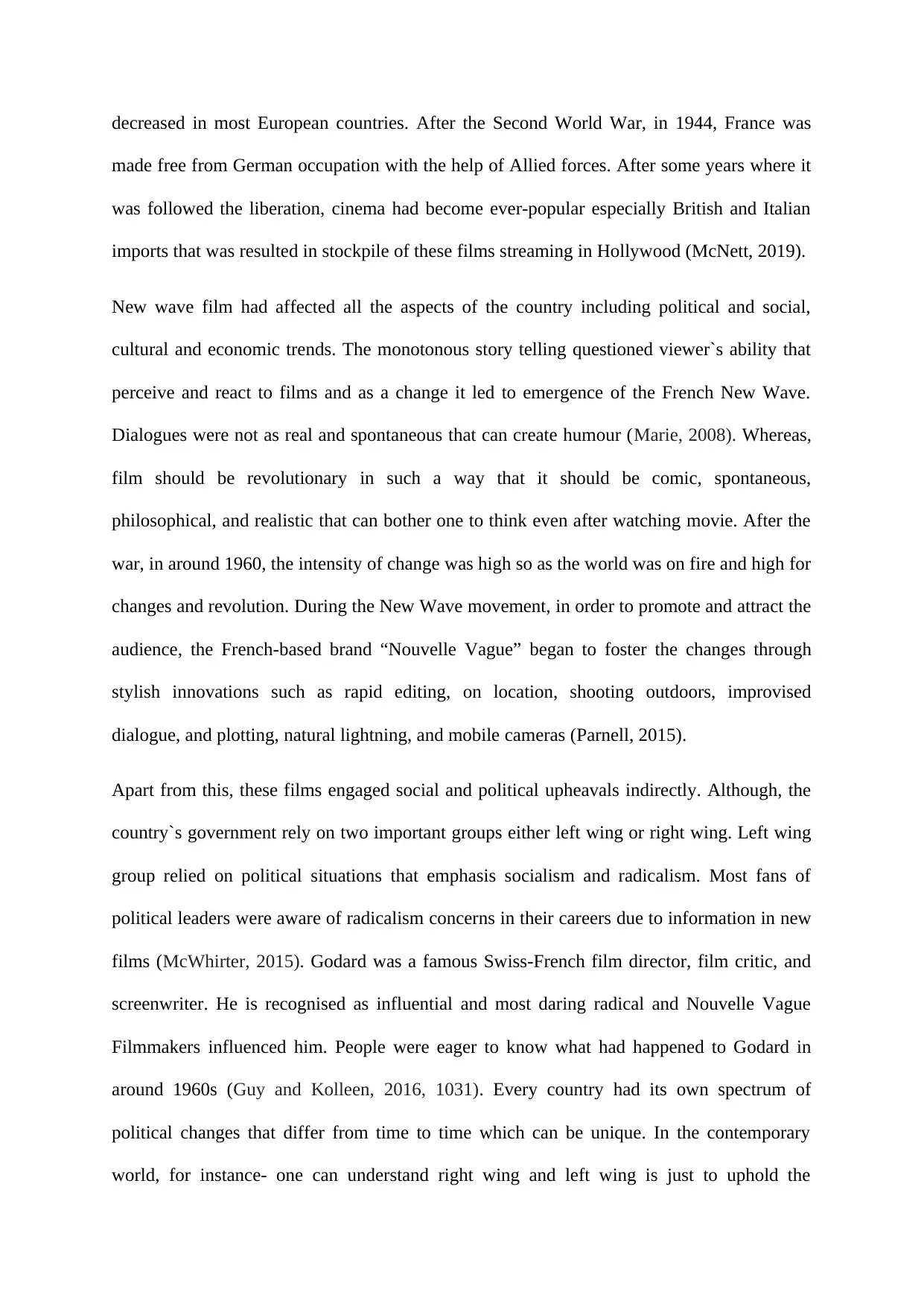
decreased in most European countries. After the Second World War, in 1944, France was
made free from German occupation with the help of Allied forces. After some years where it
was followed the liberation, cinema had become ever-popular especially British and Italian
imports that was resulted in stockpile of these films streaming in Hollywood (McNett, 2019).
New wave film had affected all the aspects of the country including political and social,
cultural and economic trends. The monotonous story telling questioned viewer`s ability that
perceive and react to films and as a change it led to emergence of the French New Wave.
Dialogues were not as real and spontaneous that can create humour (Marie, 2008). Whereas,
film should be revolutionary in such a way that it should be comic, spontaneous,
philosophical, and realistic that can bother one to think even after watching movie. After the
war, in around 1960, the intensity of change was high so as the world was on fire and high for
changes and revolution. During the New Wave movement, in order to promote and attract the
audience, the French-based brand “Nouvelle Vague” began to foster the changes through
stylish innovations such as rapid editing, on location, shooting outdoors, improvised
dialogue, and plotting, natural lightning, and mobile cameras (Parnell, 2015).
Apart from this, these films engaged social and political upheavals indirectly. Although, the
country`s government rely on two important groups either left wing or right wing. Left wing
group relied on political situations that emphasis socialism and radicalism. Most fans of
political leaders were aware of radicalism concerns in their careers due to information in new
films (McWhirter, 2015). Godard was a famous Swiss-French film director, film critic, and
screenwriter. He is recognised as influential and most daring radical and Nouvelle Vague
Filmmakers influenced him. People were eager to know what had happened to Godard in
around 1960s (Guy and Kolleen, 2016, 1031). Every country had its own spectrum of
political changes that differ from time to time which can be unique. In the contemporary
world, for instance- one can understand right wing and left wing is just to uphold the
made free from German occupation with the help of Allied forces. After some years where it
was followed the liberation, cinema had become ever-popular especially British and Italian
imports that was resulted in stockpile of these films streaming in Hollywood (McNett, 2019).
New wave film had affected all the aspects of the country including political and social,
cultural and economic trends. The monotonous story telling questioned viewer`s ability that
perceive and react to films and as a change it led to emergence of the French New Wave.
Dialogues were not as real and spontaneous that can create humour (Marie, 2008). Whereas,
film should be revolutionary in such a way that it should be comic, spontaneous,
philosophical, and realistic that can bother one to think even after watching movie. After the
war, in around 1960, the intensity of change was high so as the world was on fire and high for
changes and revolution. During the New Wave movement, in order to promote and attract the
audience, the French-based brand “Nouvelle Vague” began to foster the changes through
stylish innovations such as rapid editing, on location, shooting outdoors, improvised
dialogue, and plotting, natural lightning, and mobile cameras (Parnell, 2015).
Apart from this, these films engaged social and political upheavals indirectly. Although, the
country`s government rely on two important groups either left wing or right wing. Left wing
group relied on political situations that emphasis socialism and radicalism. Most fans of
political leaders were aware of radicalism concerns in their careers due to information in new
films (McWhirter, 2015). Godard was a famous Swiss-French film director, film critic, and
screenwriter. He is recognised as influential and most daring radical and Nouvelle Vague
Filmmakers influenced him. People were eager to know what had happened to Godard in
around 1960s (Guy and Kolleen, 2016, 1031). Every country had its own spectrum of
political changes that differ from time to time which can be unique. In the contemporary
world, for instance- one can understand right wing and left wing is just to uphold the
⊘ This is a preview!⊘
Do you want full access?
Subscribe today to unlock all pages.

Trusted by 1+ million students worldwide
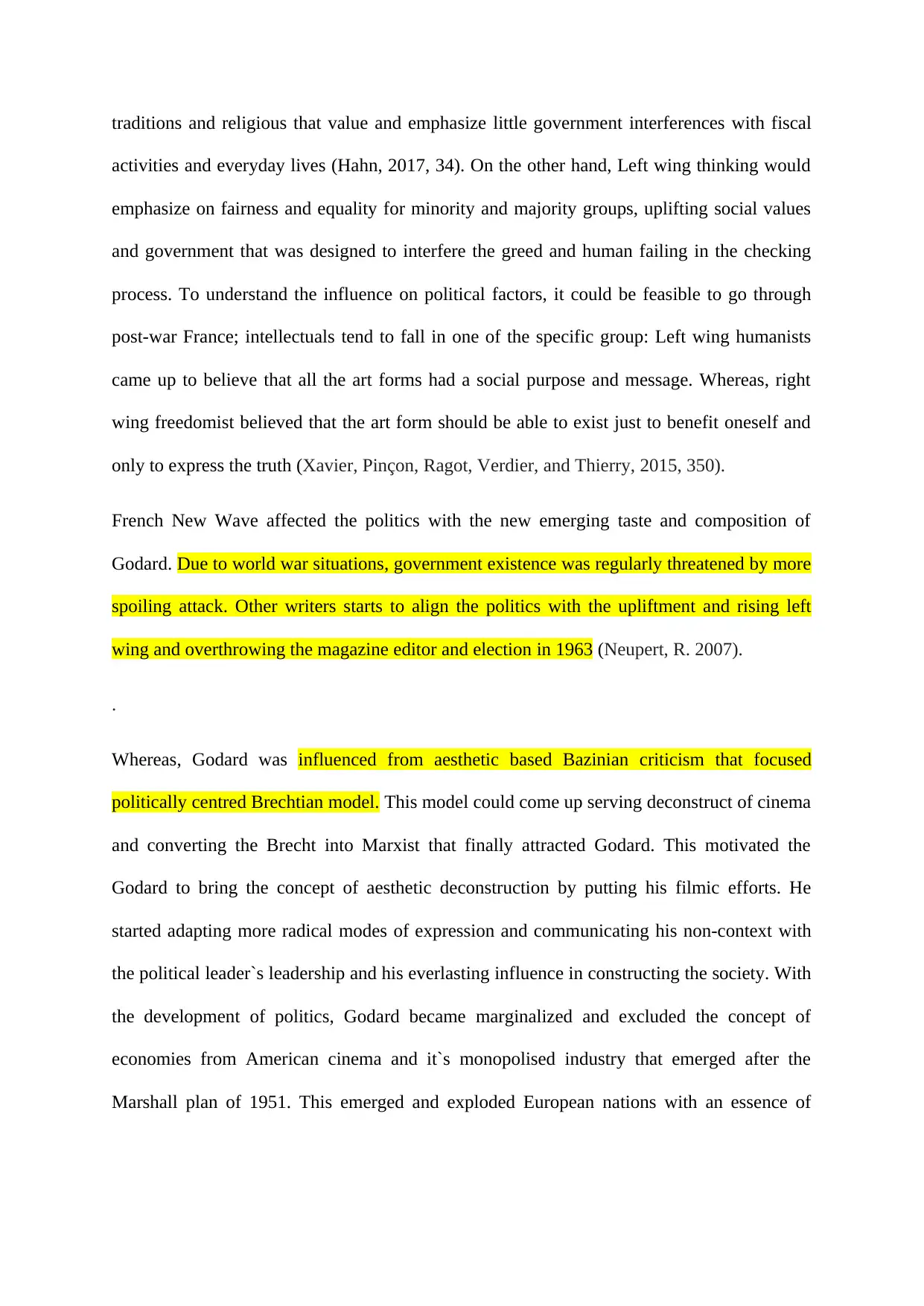
traditions and religious that value and emphasize little government interferences with fiscal
activities and everyday lives (Hahn, 2017, 34). On the other hand, Left wing thinking would
emphasize on fairness and equality for minority and majority groups, uplifting social values
and government that was designed to interfere the greed and human failing in the checking
process. To understand the influence on political factors, it could be feasible to go through
post-war France; intellectuals tend to fall in one of the specific group: Left wing humanists
came up to believe that all the art forms had a social purpose and message. Whereas, right
wing freedomist believed that the art form should be able to exist just to benefit oneself and
only to express the truth (Xavier, Pinçon, Ragot, Verdier, and Thierry, 2015, 350).
French New Wave affected the politics with the new emerging taste and composition of
Godard. Due to world war situations, government existence was regularly threatened by more
spoiling attack. Other writers starts to align the politics with the upliftment and rising left
wing and overthrowing the magazine editor and election in 1963 (Neupert, R. 2007).
.
Whereas, Godard was influenced from aesthetic based Bazinian criticism that focused
politically centred Brechtian model. This model could come up serving deconstruct of cinema
and converting the Brecht into Marxist that finally attracted Godard. This motivated the
Godard to bring the concept of aesthetic deconstruction by putting his filmic efforts. He
started adapting more radical modes of expression and communicating his non-context with
the political leader`s leadership and his everlasting influence in constructing the society. With
the development of politics, Godard became marginalized and excluded the concept of
economies from American cinema and it`s monopolised industry that emerged after the
Marshall plan of 1951. This emerged and exploded European nations with an essence of
activities and everyday lives (Hahn, 2017, 34). On the other hand, Left wing thinking would
emphasize on fairness and equality for minority and majority groups, uplifting social values
and government that was designed to interfere the greed and human failing in the checking
process. To understand the influence on political factors, it could be feasible to go through
post-war France; intellectuals tend to fall in one of the specific group: Left wing humanists
came up to believe that all the art forms had a social purpose and message. Whereas, right
wing freedomist believed that the art form should be able to exist just to benefit oneself and
only to express the truth (Xavier, Pinçon, Ragot, Verdier, and Thierry, 2015, 350).
French New Wave affected the politics with the new emerging taste and composition of
Godard. Due to world war situations, government existence was regularly threatened by more
spoiling attack. Other writers starts to align the politics with the upliftment and rising left
wing and overthrowing the magazine editor and election in 1963 (Neupert, R. 2007).
.
Whereas, Godard was influenced from aesthetic based Bazinian criticism that focused
politically centred Brechtian model. This model could come up serving deconstruct of cinema
and converting the Brecht into Marxist that finally attracted Godard. This motivated the
Godard to bring the concept of aesthetic deconstruction by putting his filmic efforts. He
started adapting more radical modes of expression and communicating his non-context with
the political leader`s leadership and his everlasting influence in constructing the society. With
the development of politics, Godard became marginalized and excluded the concept of
economies from American cinema and it`s monopolised industry that emerged after the
Marshall plan of 1951. This emerged and exploded European nations with an essence of
Paraphrase This Document
Need a fresh take? Get an instant paraphrase of this document with our AI Paraphraser

American films (Maanen, Barend, Nicholls, French, Barkwith, Bonaldo, Burningham, 2016,
70).
With the emerging help of technology that had direct impact on Gaullist government and
forced modernisation for French, culture. Gaullism was an opposition to fourth-French
republic and this group challenged unstable parliamentary government (Bennett, Hickman &
Wall, 2007). This group emerged during the second phase of French revolution and it argued
for replacement. The new wave aesthetic resistance to the mainstream of French culture had
redefined the French politics. Apart from cultural and political upheaval, the cinema suffered
similar revolution in removing Republic langlois (Stokes, Melvyn, and Jones, 2017, 80).
(Emanuele, Vincenzo, and Chiaramonte, 2018, 480).
Students gathered near the Parisian cafes, lectures to discuss on Marxism, phenomenology,
and existentialism so that they do not flock movies to theatres, and spent a lot of time just to
write about movies (Abel, 1998). Cinema was one of the distraction to the French citizens
and the choice of the people was also limited which highlighted that it could not affect the
culture. The emergence changed the taste of directors and filmmakers who started making
other new films. People started concentrating on French films because American films was
banned and German films consists of imitations of musical comedies through Hollywood in
melodramatic movies (Richard, 2017).
The only access to the French people during the revolution was 200 French films. German
censor and Marcel carne approved the films. Moreover, the growing film interest was not like
this before 1920s and 1930s because the people started losing their interest due to sense of
loss and reaching the consequence of war. This loss of early films led them to prize
expression of freedom and truth representation above all the things that become central for
their values (Freeman and Gary, 015).
70).
With the emerging help of technology that had direct impact on Gaullist government and
forced modernisation for French, culture. Gaullism was an opposition to fourth-French
republic and this group challenged unstable parliamentary government (Bennett, Hickman &
Wall, 2007). This group emerged during the second phase of French revolution and it argued
for replacement. The new wave aesthetic resistance to the mainstream of French culture had
redefined the French politics. Apart from cultural and political upheaval, the cinema suffered
similar revolution in removing Republic langlois (Stokes, Melvyn, and Jones, 2017, 80).
(Emanuele, Vincenzo, and Chiaramonte, 2018, 480).
Students gathered near the Parisian cafes, lectures to discuss on Marxism, phenomenology,
and existentialism so that they do not flock movies to theatres, and spent a lot of time just to
write about movies (Abel, 1998). Cinema was one of the distraction to the French citizens
and the choice of the people was also limited which highlighted that it could not affect the
culture. The emergence changed the taste of directors and filmmakers who started making
other new films. People started concentrating on French films because American films was
banned and German films consists of imitations of musical comedies through Hollywood in
melodramatic movies (Richard, 2017).
The only access to the French people during the revolution was 200 French films. German
censor and Marcel carne approved the films. Moreover, the growing film interest was not like
this before 1920s and 1930s because the people started losing their interest due to sense of
loss and reaching the consequence of war. This loss of early films led them to prize
expression of freedom and truth representation above all the things that become central for
their values (Freeman and Gary, 015).
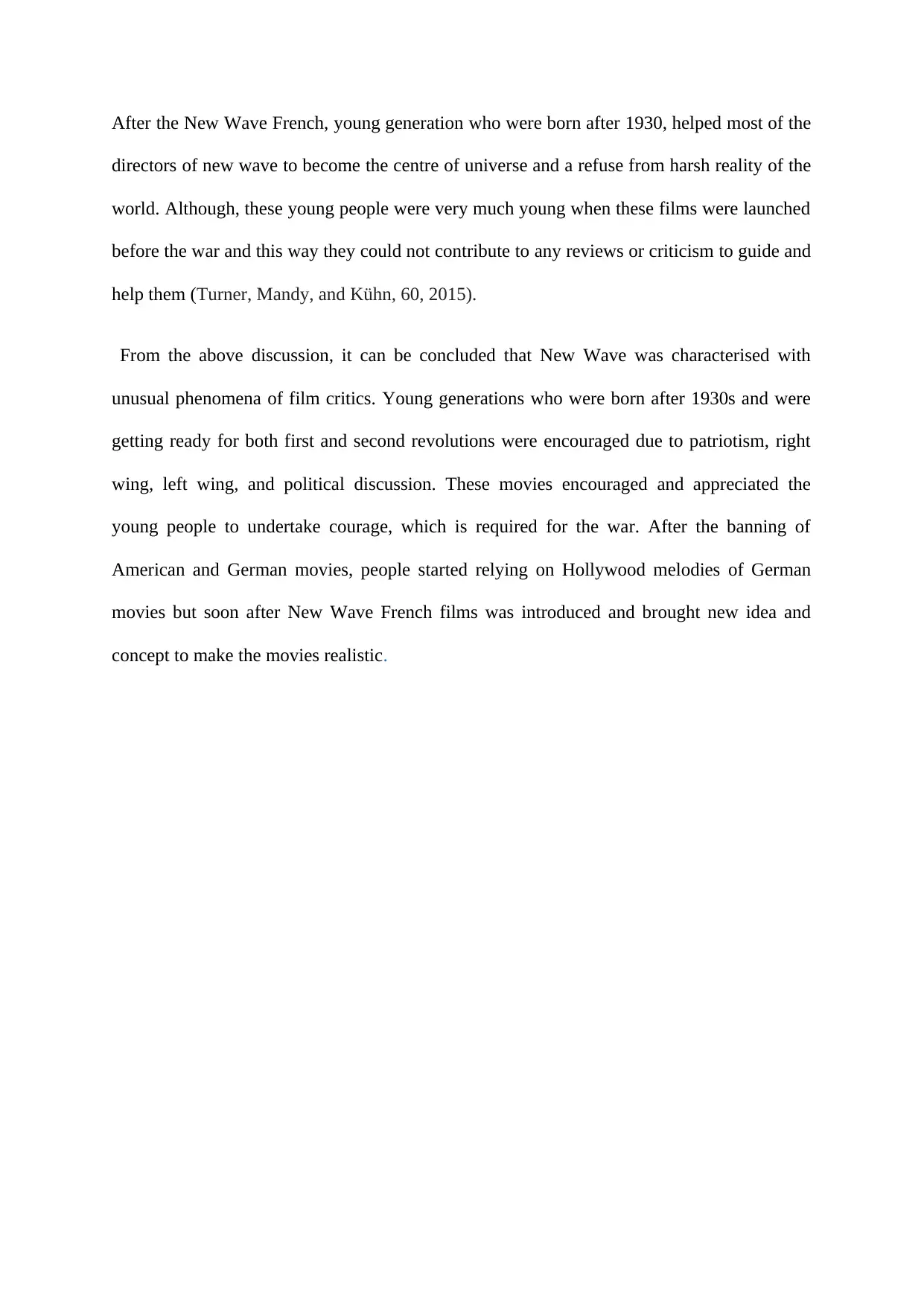
After the New Wave French, young generation who were born after 1930, helped most of the
directors of new wave to become the centre of universe and a refuse from harsh reality of the
world. Although, these young people were very much young when these films were launched
before the war and this way they could not contribute to any reviews or criticism to guide and
help them (Turner, Mandy, and Kühn, 60, 2015).
From the above discussion, it can be concluded that New Wave was characterised with
unusual phenomena of film critics. Young generations who were born after 1930s and were
getting ready for both first and second revolutions were encouraged due to patriotism, right
wing, left wing, and political discussion. These movies encouraged and appreciated the
young people to undertake courage, which is required for the war. After the banning of
American and German movies, people started relying on Hollywood melodies of German
movies but soon after New Wave French films was introduced and brought new idea and
concept to make the movies realistic.
directors of new wave to become the centre of universe and a refuse from harsh reality of the
world. Although, these young people were very much young when these films were launched
before the war and this way they could not contribute to any reviews or criticism to guide and
help them (Turner, Mandy, and Kühn, 60, 2015).
From the above discussion, it can be concluded that New Wave was characterised with
unusual phenomena of film critics. Young generations who were born after 1930s and were
getting ready for both first and second revolutions were encouraged due to patriotism, right
wing, left wing, and political discussion. These movies encouraged and appreciated the
young people to undertake courage, which is required for the war. After the banning of
American and German movies, people started relying on Hollywood melodies of German
movies but soon after New Wave French films was introduced and brought new idea and
concept to make the movies realistic.
⊘ This is a preview!⊘
Do you want full access?
Subscribe today to unlock all pages.

Trusted by 1+ million students worldwide

References
Abel, R., 1998. The ciné goes to town: French cinema, 1896-1914. Univ of California Press.
Babula, R. “THE POLITICS OF PRE-POLITICAL GODARD: ALPHAVILLE, MADE IN
USA” 2012. Accessed January 2019. http://www.thecine-files.com/past-issues/spring-2012-
issue/featured-articles/politicsgodard/
Bennett, P., Hickman, A., & Wall, P. (2007). Film studies: The essential resource. US:
Routledge.
Emanuele, Vincenzo, and Alessandro Chiaramonte. "A growing impact of new parties: Myth
or reality? Party system innovation in Western Europe after 1945." Party Politics 24, no. 5
(2018): 475-487.
Freeman, Gary P. Immigrant labor and racial conflict in industrial societies: The French and
British experience, 1945-1975. Princeton University Press, 2015.
Grove, L. Text/image mosaics in French culture: emblems and comic strips. Routledge, 2017.
Guy, Kolleen M. "Elizabeth Heath. Wine, Sugar, and the Making of Modern France: Global
Economic Crisis and the Racialization of French Citizenship, 1870–1910." (2016): 1031-
1032.
Hahn, Stacey. "2: Balzac and the French New Wave: A Problematic but Enticing
Relationship." Romantic Rapports: New Essays on Romanticism Across the Disciplines
(2017): 34.
Hillier, J. “Cahiers Du Cinema” 1950. Accessed January 2019.
https://e-edu.nbu.bg/pluginfile.php/303079/mod_resource/content/0/
Hillier_.Jim.-.Cahiers.du.Cinema.-.The.1950s.PDF-KG.pdf
Abel, R., 1998. The ciné goes to town: French cinema, 1896-1914. Univ of California Press.
Babula, R. “THE POLITICS OF PRE-POLITICAL GODARD: ALPHAVILLE, MADE IN
USA” 2012. Accessed January 2019. http://www.thecine-files.com/past-issues/spring-2012-
issue/featured-articles/politicsgodard/
Bennett, P., Hickman, A., & Wall, P. (2007). Film studies: The essential resource. US:
Routledge.
Emanuele, Vincenzo, and Alessandro Chiaramonte. "A growing impact of new parties: Myth
or reality? Party system innovation in Western Europe after 1945." Party Politics 24, no. 5
(2018): 475-487.
Freeman, Gary P. Immigrant labor and racial conflict in industrial societies: The French and
British experience, 1945-1975. Princeton University Press, 2015.
Grove, L. Text/image mosaics in French culture: emblems and comic strips. Routledge, 2017.
Guy, Kolleen M. "Elizabeth Heath. Wine, Sugar, and the Making of Modern France: Global
Economic Crisis and the Racialization of French Citizenship, 1870–1910." (2016): 1031-
1032.
Hahn, Stacey. "2: Balzac and the French New Wave: A Problematic but Enticing
Relationship." Romantic Rapports: New Essays on Romanticism Across the Disciplines
(2017): 34.
Hillier, J. “Cahiers Du Cinema” 1950. Accessed January 2019.
https://e-edu.nbu.bg/pluginfile.php/303079/mod_resource/content/0/
Hillier_.Jim.-.Cahiers.du.Cinema.-.The.1950s.PDF-KG.pdf
Paraphrase This Document
Need a fresh take? Get an instant paraphrase of this document with our AI Paraphraser
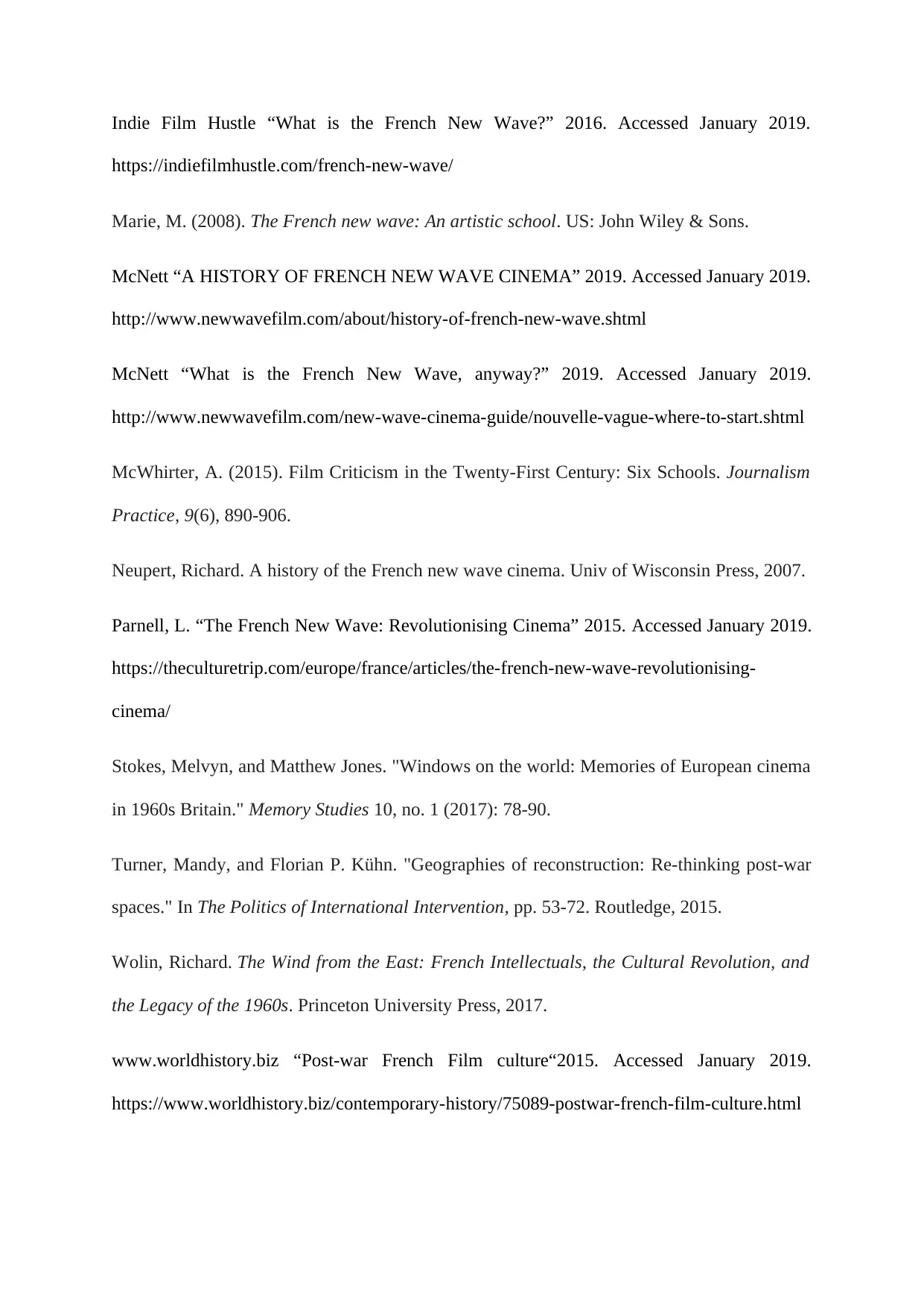
Indie Film Hustle “What is the French New Wave?” 2016. Accessed January 2019.
https://indiefilmhustle.com/french-new-wave/
Marie, M. (2008). The French new wave: An artistic school. US: John Wiley & Sons.
McNett “A HISTORY OF FRENCH NEW WAVE CINEMA” 2019. Accessed January 2019.
http://www.newwavefilm.com/about/history-of-french-new-wave.shtml
McNett “What is the French New Wave, anyway?” 2019. Accessed January 2019.
http://www.newwavefilm.com/new-wave-cinema-guide/nouvelle-vague-where-to-start.shtml
McWhirter, A. (2015). Film Criticism in the Twenty-First Century: Six Schools. Journalism
Practice, 9(6), 890-906.
Neupert, Richard. A history of the French new wave cinema. Univ of Wisconsin Press, 2007.
Parnell, L. “The French New Wave: Revolutionising Cinema” 2015. Accessed January 2019.
https://theculturetrip.com/europe/france/articles/the-french-new-wave-revolutionising-
cinema/
Stokes, Melvyn, and Matthew Jones. "Windows on the world: Memories of European cinema
in 1960s Britain." Memory Studies 10, no. 1 (2017): 78-90.
Turner, Mandy, and Florian P. Kühn. "Geographies of reconstruction: Re-thinking post-war
spaces." In The Politics of International Intervention, pp. 53-72. Routledge, 2015.
Wolin, Richard. The Wind from the East: French Intellectuals, the Cultural Revolution, and
the Legacy of the 1960s. Princeton University Press, 2017.
www.worldhistory.biz “Post-war French Film culture“2015. Accessed January 2019.
https://www.worldhistory.biz/contemporary-history/75089-postwar-french-film-culture.html
https://indiefilmhustle.com/french-new-wave/
Marie, M. (2008). The French new wave: An artistic school. US: John Wiley & Sons.
McNett “A HISTORY OF FRENCH NEW WAVE CINEMA” 2019. Accessed January 2019.
http://www.newwavefilm.com/about/history-of-french-new-wave.shtml
McNett “What is the French New Wave, anyway?” 2019. Accessed January 2019.
http://www.newwavefilm.com/new-wave-cinema-guide/nouvelle-vague-where-to-start.shtml
McWhirter, A. (2015). Film Criticism in the Twenty-First Century: Six Schools. Journalism
Practice, 9(6), 890-906.
Neupert, Richard. A history of the French new wave cinema. Univ of Wisconsin Press, 2007.
Parnell, L. “The French New Wave: Revolutionising Cinema” 2015. Accessed January 2019.
https://theculturetrip.com/europe/france/articles/the-french-new-wave-revolutionising-
cinema/
Stokes, Melvyn, and Matthew Jones. "Windows on the world: Memories of European cinema
in 1960s Britain." Memory Studies 10, no. 1 (2017): 78-90.
Turner, Mandy, and Florian P. Kühn. "Geographies of reconstruction: Re-thinking post-war
spaces." In The Politics of International Intervention, pp. 53-72. Routledge, 2015.
Wolin, Richard. The Wind from the East: French Intellectuals, the Cultural Revolution, and
the Legacy of the 1960s. Princeton University Press, 2017.
www.worldhistory.biz “Post-war French Film culture“2015. Accessed January 2019.
https://www.worldhistory.biz/contemporary-history/75089-postwar-french-film-culture.html
1 out of 8
Related Documents
Your All-in-One AI-Powered Toolkit for Academic Success.
+13062052269
info@desklib.com
Available 24*7 on WhatsApp / Email
![[object Object]](/_next/static/media/star-bottom.7253800d.svg)
Unlock your academic potential
Copyright © 2020–2025 A2Z Services. All Rights Reserved. Developed and managed by ZUCOL.



